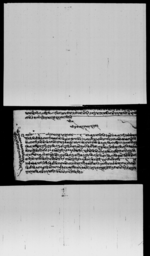A copy of a lālamohara to Raṅganātha Pauḍyāla renewing a grant of land (undated)
ID: K_0096_0013
Edited and
translated by Simon Cubelic
in collaboration with
Rajan Khatiwoda
Created: 2017-08-23;
Last modified: 2018-06-21
For the metadata of the document, click here
The accompanying edition, translation/synopsis and/or commentary are available under the terms of the Creative Commons Attribution-ShareAlike 4.0 International License
Abstract
In this copy of a lālamohara, Raṅganātha Pauḍyāla is reinstated in the possession of two irrigated fields (kheta) on both sides of the Dhobikholā in an area under the control of Deopatan as a tax-free birtābitalapa, which had earlier been granted to but later expropriated from his father Vrajanātha Pauḍyāla.Diplomatic edition
[1r]
1श्रीः\1श्रीवुवाज्यूरणवहादूरसाह2२1श्रीगुरुवाज्याव्रजनाथपंडितज्यू१1श्रीगुरुपंडितराजरंगनाथपंडितज्यू३1९३1आगे ¯ ¯ ¯ १¯ ¯ ¯ लाईसम्वत्१८३९सालमा ¯ ¯ २ ¯ ¯ वाटकुसपानिलिडल्लोसंकल्पगरीसर्वअंकमा
2रिमेटिविर्तावितलपगरीवक्स्याकोविचमाअन्यायेलेगडवडपरिछुट्याकोजगादेउपाटनकोअम्वलधोवि
3षोलापारिपन्तेकोषेततस्कोसाधपुर्वकान्ह्रीषहर्याकोमुषनेराकोषेतलुहकिल्दक्षिण•मुलवाटोलुहु
4किल्पश्चिमगुठिलुहुकिल्उत्तरगुठिनेवारकोसुनाविर्त्तारैकरलुहुकिल्येतिचारकिल्लाभित्रकपन्य
5कोपानिषेतरोपनि७०तस्कोमुरि२८०दुइसैअसिर•पूर्वधोविषोलोलुहकिल्दक्षिणवाटोलुहुकि
6ल्पश्चिमकुलोकान्ल्होचौरलुहकिल्उत्तररैकरलुहकिल्येतिचारकिलाभित्रकोधोविषोला
7व़ारिकोपानिषेतरोपनिविस२०तस्कोमुरि।८०दुवैज्माषेतमुरि३६०तीनसैसाठि ¯ ¯ ¯३ ¯ ¯ ¯ ला
8सर्वअंकमारिमेटिविर्तावितलपकोलालमोहरगरीवक्स्यौंषातिरज्मासितसर्वअंकमाफ्भयाको
9विर्तावितलपजानिभोग्यगर्नुहव़स्आसिरवादवक्सदैरहनुहव़स्स्वदतांपरदताम्वायोहरेतवसुन्ध
10राम्षष्टिवर्षसहश्राणिविष्टायांजायतेक्रिमिः॥
Translation
[1r]
Venerable Father Raṇabahādura Śāha1 2
Venerable Guru Bājyā2 Vrajanātha Paṇḍitajyū3 1
Venerable Guru Paṇḍitarāja Raṅganātha Paṇḍitajyū4 3
935
Āge: [The following two khetas] were granted by -2- (i.e., Venerable Father Raṇabahādura Śāha) to -1- (i.e., Venerable Guru Bājyā Vrajanātha Paṇḍitajyū) in the [Vikrama] era year 1839 as birtābitalapa—exempted from all taxes—after kuśa and water were brought and a saṃkalpa was performed on a clod (ḍallo) [from each plot], of which in the interim he was unlawfully dispossessed when he was [politically] weakened: The kheta in the Pante [tract] on the further side of the Dhobikholā in the area under the control of Deopatan has the [following] four border demarcations: east to the kheta close to the spring (mukha) of the Kānhrī rivulet; south to the main path; west to a guṭhī [field]; north to the [same] guṭhī [field], the sunābirtā of a Newar and raikara land. This irrigated land (pānikheta) in the Kapanya [tract] within these four boundaries [consists of] 70 ropanīs, equating to 280, [in words] two hundred eighty, murīs. The irrigated land on the near side of the Dhobikholā within the following four border demarcations consists of 20, [in words] twenty, ropanīs equating to 80 murīs: east to the Dhobikholā, south to the path, west to a water channel, terrace wall (kānlho) and common pasture ground (caura), north to raikara land. Both khetas [amount] in total to 360, [in words] three hundred sixty, murīs. We issue [this] lālamohara to -3- (i.e., Venerable Guru Paṇḍitarāja Raṅganātha Paṇḍitajyū) for [these two khetas] as birtābitalapa exempted from all taxes. Enjoy [these two khetas] with content, knowing them to be birtābitalapa exempted from all taxes. Keep on blessing us. Whoever seizes the land, whether given by himself or somebody else, will be reborn as a worm in feces for sixty thousand years.
Commentary
It is probable that the need to renew the grant of land which is the subject of this document resulted from contemporaneous factionalism at the Nepalese darabāra. Vrajanātha was an opponent of Bahādura Śāha (cf. Whelpton 1991: 37), whence one may assume that he was dispossessed of his land during the latter’s reign, around the same time he was forced to leave Nepal. It is no surprise that the privileges were restored to Vrajanātha's son Raṅganātha, who returned together with Raṇabahādura to Nepal in 1804 and became a rājaguru at the Nepalese court. Even though the original date is not preserved on this copy, from a similar document reinstating Raṅganātha’s right to his father's property dated 1806 CE (cf. K_0096_0011) one can assume that it was issued around the same time by King Gīrvāṇayuddha Vikrama Śāha.

